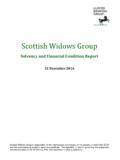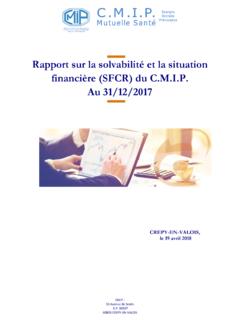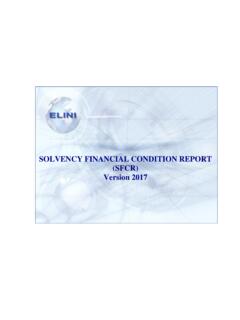Transcription of Solvency and Financial Condition Report
1 The New India Assurance Company Limited UK BRANCH (A Third Country Branch of The New India Assurance Co Ltd, Mumbai, India) Solvency and Financial Condition Report SFCR 2016-17 The New India Assurance Co Ltd, UK Branch SFCR 2016-17 Page 2 Table of Contents Executive Auditors Head of Third Country Branch Function s statement .. 6 A. Business and Performance .. 10 10 Underwriting 14 Investment Performance .. 15 Performance of other activities .. 16 Any other information .. 16 B. System of Governance .. 16 General information on the System of Governance .. 16 The Executive Management of the Branch .. 17 Structure of Governance Arrangements .. 17 Risk Management System, including Own Risk Solvency Assessment.
2 21 Internal Control Systems .. 27 Overview .. 27 Internal Audit Function .. 27 Overview .. 27 Actuarial Function .. 28 Outsourcing .. 29 Any other information .. 29 C. Risk Profile .. 29 D. Valuation for Solvency Purposes .. 37 Technical Provisions .. 40 Other Liabilities .. 45 Alternative Valuation Methods .. 46 Any other information .. 46 E. Capital Management .. 46 Own Funds .. 46 Solvency Capital Requirement and Minimum Capital Requirement .. 48 Use of the duration-based equity risk sub-module in the calculation of the SCR .. 50 Differences between Standard Formula and any Internal Model used .. 50 Non-compliance with SCR and MCR .. 50 Any other information .. 50 Appendix and additional information Appendix 1 Quantitative Reporting Templates The New India Assurance Co Ltd, UK Branch SFCR 2016-17 Page 3 Executive Summary This document is The New India Assurance Branch Limited UK Branch (referred to as NIA - UK , branch and we ) Solvency Financial Condition Report ( SFCR ) as at the year ended 31st March 2017.
3 This SFCR covers NIA - UK on a solo basis. As this is the first year in which NIA - UK has published an SFCR, no comparatives against prior year are included in this document. NIA - UK has prepared this SFCR to provide information on our Solvency ( our ability to pay liabilities, primarily current and future policyholder claims) and how we manage the Financial strength of the Branch. The Report covers the Business and Performance of the Branch, its System of Governance, Risk Profile, Valuation for Solvency Purposes and Capital Management. The Branch s Executive Management Team has ultimate responsibility for all of these matters, supported by other control functions that are in place to monitor and manage the business.
4 The information in this Report is from our most recent Financial year, which is the year ended 31st March 2017. The Branch s reporting and presentational currency is GBP. Branch Background NIA - UK is owned by the Government of India, and operates in the UK as a third country branch of the New India Assurance head office. NIA - UK operates out of London and Ipswich, writing both reinsurance contracts and direct insurance. The majority of business written from Ipswich consists of direct operations of UK provincial business combined risks (motor, employer s liability, public liability and property for small-medium enterprises). Business written from London is mainly facultative property and is supplemented by property treaty business.
5 NIA UK is authorised by the Prudential Regulation Authority (PRA), and jointly regulated by the Financial Conduct Authority (FCA) and the PRA. Report Contents Summary The following is a high level description of the contents of each section in this document. A. Business and performance This section describes our business performance and significant events during the year, our structure, how we are regulated and who our auditors are. During the Financial year ending 31st March 2017, NIA UK completed a gross written premium of million - consisting of million from combined direct operations and million from inward reinsurance operations. This means a growth of 10% against the premium completion of previous year.
6 The combined ratio of the overall operations was kept under 90% on a net earned basis due to prudent underwriting, claims control and control on management expenses. B. System of Governance This section outlines our system of governance and risk management, and how the branch is directed and controlled. We also describe our remuneration policy and practices ,and our adherence with the Fit and Prpoer Requiements from the FCA when appointing employees who effectively run the branch or have any other key functions. NIA - UK employs systems of governance, commensurate with the nature, size of the business, its products and risk profile, through a combination of internal and external knowledge and resources.
7 As part of its systems of governance, NIA - UK has three lines of defence. The first line of defence is operated by the management of each business area. The second line of defence is with the risk compliance team and the third line of defence rests with the internal auditors. Management information produced to support the governance framework is reviewed regularly by the Executive Management. We also describe our remuneration policy and practices, and our The New India Assurance Co Ltd, UK Branch SFCR 2016-17 Page 4 adherence with the Fit and Proper Requirements from the FCA when appointing employees who effectively run the branch or have other key functions.
8 C. Risk profile This section describes our risk profile, including risk exposures, concentrations, mitigation and sensitivity. NIA UK s risk profile is stable and generally changes only gradually from year to year. However, the work we do to mitigate and manage risk is enhanced and strengthened each year. NIA UK underwrites a well-diversified portfolio of direct insurance and reinsurance operations (Property Facultative and Treaties on proportional and non-proportional basis). The standard formula SCR risk profile is shown in the below chart. As evidenced in the chart, non-life underwriting risk and counterparty risk make up the largest portion of the standard formula SCR risk profile.
9 The standard formula SCR is the minimum level of capital NIA UK should hold to protect the business from a 1-in-200-year event. In order to help mitigate underwriting risks, NIA - UK maintains a disciplined underwriting philosophy that is supported by risk appetites set at the aggregate level as well as individual class. NIA - UK benefits from a comprehensive reinsurance programme that provides protection for both direct insurance and reinsurance business. NIA - UK undertakes stress and scenario testing used to test the branch resilience. The results of the analysis showed that the most material impact on the SCR arose from a natural catastrophe event affecting the UK and Europe.
10 The analysis undertaken indicates NIA- UK is strongly capitalised and it holds a SCR to withstand an extreme event with a return period of 1-in-200 and therefore NIA - UK s underwriting risk profile was assessed to be resilient to withstand severe shocks and is within the executive management approved risk appetite. D. Valuation for Solvency purposes In this section, we describe the bases and methods used for the valuation of our assets, technical provisions and other liabilities. An analysis of the differences between the valuation of assets and liabilities under Solvency II in comparison to UK GAAP is provided in Sections D1 and D2 below. These sections provide a background to the methods adopted under Solvency II including the required inputs and any judgements or assumptions made.





